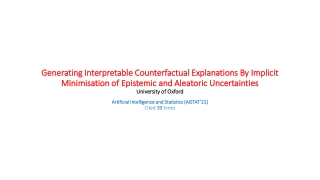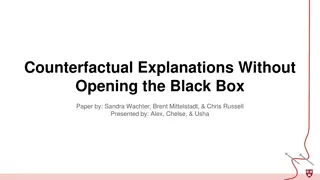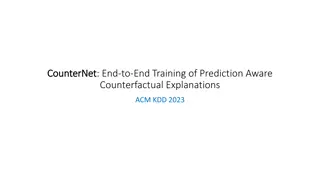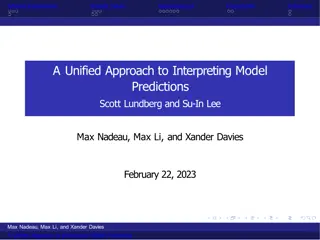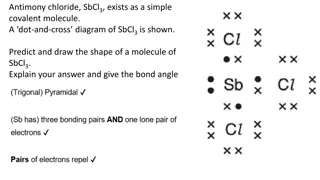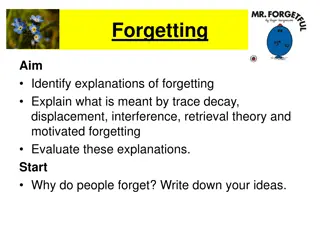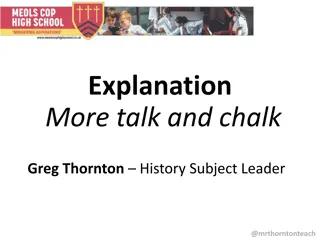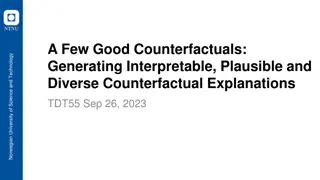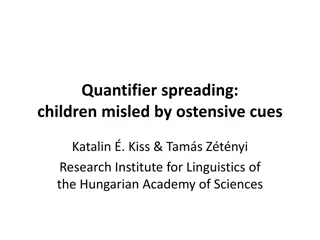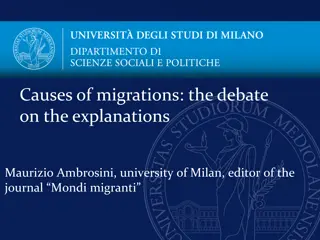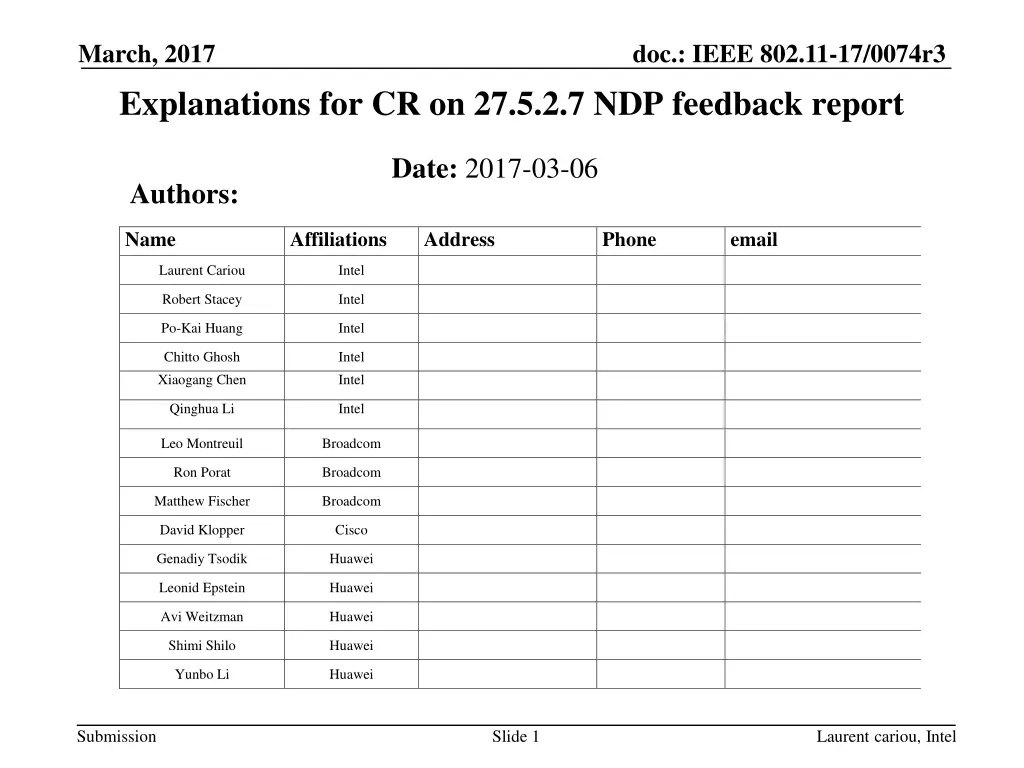
IEEE 802.11-17/0074r3 NDP Feedback Mechanism
Enhance system efficiencies with IEEE 802.11-17/0074r3 proposing a feedback mechanism for HE APs to collect short feedbacks from HE STAs efficiently. Learn about the trigger frame proposal and new trigger type definition for NDP feedback reports, aiming to improve scheduling and resource requests in wireless network environments.
Download Presentation

Please find below an Image/Link to download the presentation.
The content on the website is provided AS IS for your information and personal use only. It may not be sold, licensed, or shared on other websites without obtaining consent from the author. If you encounter any issues during the download, it is possible that the publisher has removed the file from their server.
You are allowed to download the files provided on this website for personal or commercial use, subject to the condition that they are used lawfully. All files are the property of their respective owners.
The content on the website is provided AS IS for your information and personal use only. It may not be sold, licensed, or shared on other websites without obtaining consent from the author.
E N D
Presentation Transcript
March, 2017 doc.: IEEE 802.11-17/0074r3 Explanations for CR on 27.5.2.7 NDP feedback report Date: 2017-03-06 Authors: Name Affiliations Address Phone email Laurent Cariou Intel Robert Stacey Intel Po-Kai Huang Intel Chitto Ghosh Xiaogang Chen Intel Intel Qinghua Li Intel Leo Montreuil Broadcom Ron Porat Broadcom Matthew Fischer Broadcom David Klopper Cisco Genadiy Tsodik Huawei Leonid Epstein Huawei Avi Weitzman Huawei Shimi Shilo Huawei Yunbo Li Huawei Submission Slide 1 Laurent cariou, Intel
March, 2017 doc.: IEEE 802.11-17/0074r3 Background (1) It is well accepted that being able to get a very short simultaneous feedback from a high number of STAs (all STAs) improve the 11ax system and power efficiencies [1], [3] Many feedbacks require 1 bit: PS-Poll (power efficiency), Channel Availability (collisions avoidance) Other feedbacks could be 2 bit. For example: How many buffered Bytes for transmission: 0, 1 to 1000, 1000 to 5000, > 5000 ? A short simultaneous resource request feedback (1 or several bits) capable of supporting a high number of STAs is needed for an efficient UL MU simultaneous scheduling in addition to the existing (or enhanced) piggybacked buffer information Less overhead for resource request feedback than polling method Low and stable latency for resource request feedback, compared to possibly high and unpredictable latency with CSMA-CA in dense environments Submission Slide 2 Laurent cariou, Intel
March, 2017 doc.: IEEE 802.11-17/0074r3 Background (2) In Nov. 2016, added subclause 25.5.2.7 to the spec: 25.5.2.7 NDP feedback report procedure The NDP feedback report is a mechanism for an HE AP to collect short feedbacks from a very high number of HE STAs, in an efficient manner. The feedbacks (e.g. resource requests) are sent without data payloads in response to a Trigger frame. The feedbacks are not for channel sounding. This mechanism is optional for non-AP STA. But details of the NDP feedback mechanism are TBD Contribution 44r1 proposes a signaling technique for the NDP feedback mechanism that can handle a high number of STAs and is power and air time efficient This contribution proposes to define a new trigger type for NDP feedback report and the procedure for an HE non-AP STA to know, based on the trigger frame, if it can respond and what parameters to use to respond Submission Slide 3 Laurent cariou, Intel
March, 2017 doc.: IEEE 802.11-17/0074r3 Trigger frame proposal We propose to define a new trigger type for NDP feedback report This is the cleanest solution, as specific common info field parameters are needed for this mechanism and as this mechanism should be generic and work for multiple types of feedbacks We propose that this trigger type contains all the information so that: STAs can know if they are scheduled STAs can know on which allocation they can transmit their response, that allocation being unique STAs can know what is the type of feedback that is requested and how many bits for the feedback Submission Slide 4 Laurent cariou, Intel
March, 2017 doc.: IEEE 802.11-17/0074r3 Proposed design for the trigger frame Use information in common info field and trigger dependent common info field. Feedb ack type Feedb ack size Sched uling Type GroupI D Starting STA Probe request option Target RSSI Number of users per set of tones Duplicate Ressourc e request buffer threshol d 4 Bits: 4 8 6 11 1 7 2 1 Trigger dependent common info field Submission Slide 5 Laurent cariou, Intel
March, 2017 doc.: IEEE 802.11-17/0074r3 Feedback types We propose to define types of feedback, and a field to identify the type We define the resource request type We can then easily define others For each feedback type, we can define and limit the modes of operation: number of bits of feedback For instance, if feedback type is resource request, it has to be a 1-bit feedback and the mapping is the following For a 1-bit feedback, PHY design allows to have 3 states a state with no-response A state with a bit received with a value of 0 Defines a resource request for a small payload A state with a bit received with a value of 1 Defines a resource request for a larger payload Mode for selecting the scheduled users Range of AIDs GroupID b0 Value 0 Description Resource buffered transmission between 1 and resource_request_buffer_ threshold Resource request buffered bytes transmission resource_request_buffer_ threshold request bytes with for 1 with for above Submission Slide 6 Laurent cariou, Intel
March, 2017 doc.: IEEE 802.11-17/0074r3 Feedback types With this solution, it is also possible to define multiple feedbacks Some feedback type indexes are associated with a single pre-defined feedback Some feedback type indexes can be associated with multiple pre-defined feedbacks For each index, there is a clear spec sub-section that describes how the bits are assigned to each feedback (including the number of bits) and how to encode them Submission Slide 7 Laurent cariou, Intel
March, 2017 doc.: IEEE 802.11-17/0074r3 Scheduling the STAs with range of AID If Scheduling type field is set to zero, the STAs are scheduled with a range of AIDs The trigger frame identifies the group of STAs that can respond: This is done by defining a range of consecutive AIDs, by using: Starting STA field in the trigger frame And the parameters to know how many AIDs are scheduled (NAIDs) The STAs whose AID is between Starting STA and Starting STA + NAIDs are scheduled The index of the STA AID compared to Starting STA is used to know the allocation This allows: Unique allocation per AID No need for assigning the allocation in a static manner with any other frame exchanges Starting STA field allows to define different groups of STAs and target the AID range that associated STAs are using Submission Slide 8 Laurent cariou, Intel
March, 2017 doc.: IEEE 802.11-17/0074r3 Scheduling the STAs with groupID If Scheduling type field is set to 1, the STAs are scheduled with groupID The trigger frame identifies the group of STAs that can respond: The groupID field is set to a predefined group ID The Starting STA field indicates at which index in the group the range of STAs are scheduled STAs that belong to the group and whose index is between Starting STA and Starting STA + NAIDs are scheduled The index of the STA in the groupID compared to Starting STA is used to know the allocation Submission Slide 9 Laurent cariou, Intel
March, 2017 doc.: IEEE 802.11-17/0074r3 GroupID management We propose to enable group management as in 11ac Frame unicasted to a STA to indicate to which group it is a member and the position of that STA in these groups. 9 bits to indicate groups positions (instead of 2 with 11ac) For this, we propose to define a new HE Group ID Management frame (HE action frame) It replicates 11ax groupID management It includes Membership status array field already defined in 9.4.1.54 It includes a new HE user Position Array field (see below with the changes compared to User Position Array field used in 11ac) B0 B1 B63 B0 B1 B2 B3 B126 B127 Membership Status In Group ID 0 Membership Status In Group ID 1 Membership Status In Group ID 63 User Position In Group ID 0 User Position In Group ID 1 User Position In Group ID 63 1 1 1 Bits: 2 9 2 9 2 9 Membership Status Array field HE User Position Array field Submission Slide 10 Laurent cariou, Intel
March, 2017 Deriving parameters for transmission of the response (allocation) doc.: IEEE 802.11-17/0074r3 The response follows the UL MU operation The parameters of the trigger-based PPDU are derived from the trigger frame, and each AID has a unique combination of: 242 RU allocation Tone sets allocations within each RU NUM_STS These are calculated based on: AID range option: index AID-AID start and parameters from trigger frame: feedback size, BW, number of users per set of tones Group ID: index STA position in the group Index start and parameters from trigger frame: feedback size, BW, number of users per set of tones Submission Slide 11 Laurent cariou, Intel
March, 2017 Deriving parameters for transmission of the response (allocation) doc.: IEEE 802.11-17/0074r3 STAs are assigned in order depending on their AID or GroupID index, starting from Starting STA: Assign all frequency allocations on the whole bandwidth using SS1 first 18 first STAs for a 20MHz BW 36 first STAs for a 40MHz BW (if duplicate =0) Then assign the following STAs using incremented SSs. Next 18 STAs are assigned the same allocations but with SS2 For BW > 20MHz: If duplicate field is equal to 0, allocations in frequency are done in order on the whole bandwidth 18 first STAs in the first 20MHz, 18 following STAs in the second 20MHz If duplicate field is equal to 1, the same set of users are assigned the same allocation in each 20MHz Submission Slide 12 Laurent cariou, Intel
March, 2017 doc.: IEEE 802.11-17/0074r3 Example of user mapping Pm-c1 Pm-c2 0 1 17 18 19 35 36 37 53 54 55 71 TS0 TS1 TS18 TS0 TS1 TS18 TS0 TS1 TS18 TS0 TS1 TS18 72 73 RU1 89 90 91 Pm-c1Pm-c2 0 1 17 18 19 35 TS0 TS1 TS18 TS0 TS1 TS18 36 37 242 RU1 RU2 107 108 109 53 54 55 RU3 125 126 127 242 RU2 71 40MHz 2 P-matrix codes RU4 143 80MHz 2 P-matrix codes Submission Slide 13 Laurent cariou, Intel
March, 2017 doc.: IEEE 802.11-17/0074r3 Power control TargetRSSI is included in the trigger dependent common info field This enables power control with the same target for all STAs Submission Slide 14 Laurent cariou, Intel
March, 2017 Specific mode for request for probe response doc.: IEEE 802.11-17/0074r3 groupID field set to the value of a groupID Associated STAs belonging to the signaled group ID shall respond as explained in previous slides. If the field probe request option is set to 1, it indicates that the last available allocation is assigned for non-associated STAs to send single bit indicating probe request. This may be useful in HD/VHD deployments, such as stadiums or malls. The AP shall make sure that there is one allocation at the end of the bitmap not assigned to the STAs belonging to the groupID Non-zero value of the allocation assigned for probe requests in the received NDP feedback indicates that at least one STA requested a Probe Response frame. A single Probe Response shall be transmitted by the AP with the Addr1 set to Broadcast Address allowing all the non-associated STAs that transmitted the single-bit probe request to receive the probe response, preventing multiple APs from transmitting a probe-response. Submission Slide 15 Laurent cariou, Intel
March, 2017 doc.: IEEE 802.11-17/0074r3 Summary We propose to progress on the definition of the NDP feedback report procedure New trigger type Parameters to identify the scheduled STAs Parameters for scheduled STAs to derive the parameters for the response Resource request type Submission Slide 16 Laurent cariou, Intel
March, 2017 doc.: IEEE 802.11-17/0074r3 Straw Poll 2bis Which option do you prefer? STAs scheduled by a NDP feedback report trigger frame variant with a feedback type set to resource request are identified by: Option 1: a single mode: a range of AIDs Option 2: 2 modes: a mode with a range of AIDs and a mode with groupID Submission Slide 17 Laurent cariou, Intel
March, 2017 doc.: IEEE 802.11-17/0074r3 Straw Poll 2 Do you agree to define a new NDP feedback report trigger frame variant Submission Slide 18 Laurent cariou, Intel
March, 2017 doc.: IEEE 802.11-17/0074r3 Strawpoll #3 Do you agree to define that the STAs scheduled by a NDP feedback report trigger frame variant with a feedback type set to resource request are identified by Option 1: one range of AIDs Option 2: one or multiple ranges of AIDs Note: A range of AIDs is defined to be between AID start and AID start + NAIDs - 1. The trigger frame includes the AID start parameter and the needed parameters to calculate NAIDs Submission Slide 19 Laurent cariou, Intel
March, 2017 doc.: IEEE 802.11-17/0074r3 Submission Slide 20 Laurent cariou, Intel
March, 2017 doc.: IEEE 802.11-17/0074r3 Straw Poll #3 Do you agree that the RU allocation, RU tone set allocation and starting_STS_num for the NDP feedback response from an HE non- AP STA are calculated based on common parameters in the new NDP feedback report trigger frame variant. A duplicate field is defined in the new NDP feedback report trigger frame variant to indicate that STAs allocation are calculated on with a 20MHz bandwidth and are duplicated on the other 20MHz channels Submission Slide 21 Laurent cariou, Intel
March, 2017 doc.: IEEE 802.11-17/0074r3 Straw Poll #4 Do you agree that, for resource request feedback type: The feedback size is set to 1 bit only The NDP feedback report trigger frame variant has a field called resource request buffer threshold Scheduled STAs send a 0 for the NDP feedback report to indicate a resource request with buffer size below the resource request buffer threshold Scheduled STAs send a 1 for the NDP feedback report to indicate a resource request with buffer size above the resource request buffer threshold Submission Slide 22 Laurent cariou, Intel
March, 2017 doc.: IEEE 802.11-17/0074r3 Straw Poll #5 Do you agree with the mode defined in slide 20 to allocate one allocation to all unassociated STAs to make a request for a transmission by the AP of a probe response. Submission Slide 23 Laurent cariou, Intel
March, 2017 doc.: IEEE 802.11-17/0074r3 References [1] IEEE 802.11-16/1367r0: NDP feedback report [2] IEEE 802.11-15/1334r1: HE-LTF sequence design [3] IEEE 11-17-0044-00-00ax-NDP short feedback design Submission Slide 24 Laurent cariou, Intel
March, 2017 doc.: IEEE 802.11-17/0074r3 Straw Poll #4bis Which option do you prefer: The resource request buffer threshold allows to make 2 levels of resource requests, one for a payload smaller than the threshold, one for a payload higher than the threshold Option 1: The resource request buffer threshold is indicated in the eliciting NDP feedback report poll trigger frame Option 2: The resource request buffer threshold is indicated in an IE sent by the AP Submission Slide 25 Laurent cariou, Intel
March, 2017 doc.: IEEE 802.11-17/0074r3 Annex PHY design currently proposed Submission Slide 26 Laurent cariou, Intel
March, 2017 doc.: IEEE 802.11-17/0074r3 How to define the NDP feedback mechanism? UL MU transmission in response to a trigger frame Use frequency dimension for many small orthogonal allocations To avoid collisions, assign orthogonal allocations to users No data payload (NDP), STAs transmit energy on one orthogonal allocation for feedback with spreading gain in time domain for PHY robustness For minimal changes to the current PHY, we propose to use UL MU NDP simultaneous transmissions in response to a trigger frame and to define orthogonal allocations (resource block RBs) to multiplex different STAs feedbacks These orthogonal allocations (RBs) are defined by using different frequency tone sets Submission Slide 27 Laurent cariou, Intel
March, 2017 Overview of proposed signaling for Short Feedback doc.: IEEE 802.11-17/0074r3 For each 20MHz, the 242 tones RU are divided into 18 tones sets. Each tone set is made of 12 tones that are equally distributed over the RU (2 tones adjacent to each other) 1 allocation is made of 1 tone sets and a SS 1 or multiple allocations can be uniquely assigned to one STA 1 bit can be transmitted using 1 allocation (1 tone sets, made of 2 subsets of 6 tones) 1 is sent by modulating to first tone subset and not the second one 0 is sent by modumation the second subtone set and not the first one Channel estimation is not needed for detection AP and STAs must have a prior agreement on allocation assignement Submission Slide 28 Laurent cariou, Intel
March, 2017 doc.: IEEE 802.11-17/0074r3 Proposed distribution of tones over 242 tones Tone set 1 DC Null DC Null DC Null Tone set 2 ... ... ... ... ... ... Frequence 242Tone RU Submission Slide 29 Laurent cariou, Intel
March, 2017 Tone set indices for each 20 MHz: IULf doc.: IEEE 802.11-17/0074r3 P-Matrix 1x1 P-Matrix 2x2 P-Matrix 4x4 2 bit or 1 bit high power 1 bit Tone sets Tone sets Tone sets b0 = 1 b0 = 0 b1 = 1 b1 = 0 1 1,2 1,2,3,4 -113,-77,-41,6,42,78 -112,-76,-40,7,43,79 -95,-59,-23,24,60,96 -94,-58,-22,25,61,97 2 : : -111,-75,-39,8,44,80 -110,-74,-38,9,45,81 -93,-57,-21,26,62,98 -92,-56,-20,27,63,99 3 : : -109,-73,-37,10,46,82 -108,-72,-36,11,47,83 -91,-55,-19,28,64,100 -90,-54,-18,29,65,101 4 : : -107,-71,-35,12,48,84 -106,-70,-34,13,49,85 -89,-53,-17,30,66,102 -88,-52,-16,31,67,103 5 : : -105,-69,-33,14,50,86 -104,-68,-32,15,51,87 -87,-51,-15,32,68,104 -86,-50,-14,33,69,105 6 : : -103,-67,-31,16,52,88 -102,-66,-30,17,53,89 -85,-49,-13,34,70,106 -84,-48,-12,35,71,107 7 : : -101,-65,-29,18,54,90 -100,-64,-28,19,55,91 -83,-47,-11,36,72,108 -82,-46,-10,37,73,109 8 : : -99,-63,-27,20,56,92 -98,-62,-26,21,57,93 -81,-45,-9,38,74,110 -80,-44,-8,39,75,111 9 17,18 33,34,35,36 -97,-61,-25,22,58,94 -96,-60,-24,23,59,95 -79,-43,-7,40,76,112 -78,-42,-6,41,77,113 10 19,20 37,38,39,40 -95,-59,-23,24,60,96 -94,-58,-22,25,61,97 11 : : -93,-57,-21,26,62,98 -92,-56,-20,27,63,99 12 : : -91,-55,-19,28,64,100 -90,-54,-18,29,65,101 13 : : -89,-53,-17,30,66,102 -88,-52,-16,31,67,103 14 : : -87,-51,-15,32,68,104 -86,-50,-14,33,69,105 15 : : -85,-49,-13,34,70,106 -84,-48,-12,35,71,107 16 : : -83,-47,-11,36,72,108 -82,-46,-10,37,73,109 17 : : -81,-45,-9,38,74,110 -80,-44,-8,39,75,111 18 35,36 69,70,71,72 -79,-43,-7,40,76,112 -78,-42,-6,41,77,113 Submission Slide 30 Laurent cariou, Intel
March, 2017 Max # of STAs that can simultaneously send the UL Short Feedback doc.: IEEE 802.11-17/0074r3 Response = 1 bit Nss = 1 Nss = 2 Nss = 4 Nss = 1 Nss = 2 Nss = 4 18 36 72 36 72 144 72 144 288 144 288 576 Response = 2 bit BW 20 MHz 40 MHz 80 MHz 160 MHz 9 18 36 72 144 36 72 144 288 18 36 72 Submission Slide 31 Laurent cariou, Intel
March, 2017 doc.: IEEE 802.11-17/0074r3 Straw Poll 1 Do you agree to modify the spec following the comment resolutions in document 17-073r1? Submission Slide 32 Laurent cariou, Intel

